Cast iron plant is a stalwart of house plants (our cast iron plant is called Margaret aka. The Iron Lady and she is just that). Although they may not be as readily available to purchase as other, maybe more trendy house plants, once you stumble across one make sure you snap it up as it will be a long term investment you won't regret.
In this guide, we’re going to share every detail of this beloved plant that has been with us through thick and thin, and hopefully give some cast iron plant care tips so you can see yours thrive too.
More...
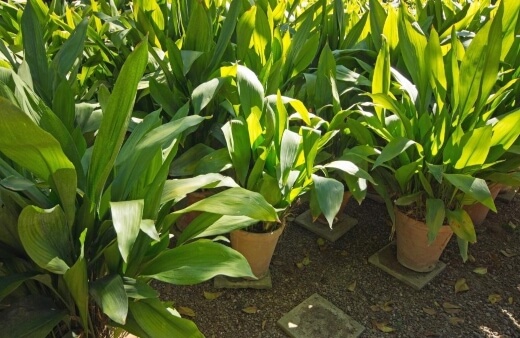
Genus: | Aspidistra |
|---|---|
Species: | A. elatior |
Family: | Asparagaceae |
Common Names: | Cast Iron Plant, Bar Room Plant |
Location: | Usually indoor, but grows outdoors in most of Australia |
Type: | Evergreen Foliage |
Growth: | 2ft tall, 2ft wide |
Sun requirements: | Dappled Shade |
Foliage Colour: | Dark green |
Flower Colour: | Purple |
Flowering: | Summer |
Maintenance level: | Low |
Poisonous for pets: | Non-toxic to cats and dogs |
What is the Cast Iron Plant?
Also known as the bar room plant, the cast iron has been a firm favourite since the Victorians needed hardy houseplants that would survive in their dimly lit, smoke ridden and draughty homes.
The parlour palm and cast iron plant would easily tolerate these less than perfect indoor conditions so became must-haves in Victorian decor featuring in homes, bars, ballrooms, theatres etc.
Its popularity did fall out of favour for decades as the interest in more exotic looking and tropical house plants grew, the unassuming cast iron fell into the foreground, but with home flora enthusiasts wanting to fill even the bleakest and most troublesome corners of their homes with greenery it's back in fashion.
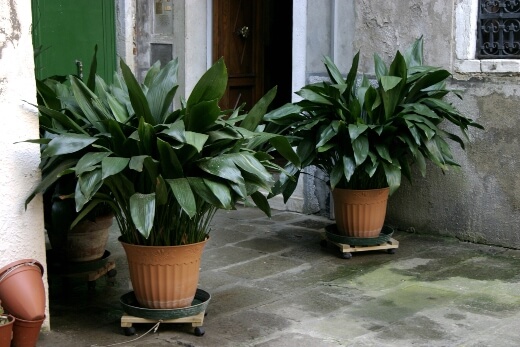
Bar Room Plant’s Natural Habitat
Cast Iron Plants are native to Japan, Taiwan and Southeastern Asia. They typically colonise under trees, woodland and rainforest canopy where shade is prevalent.
Where the floor is rich in organic matter, the Aspidistra elatior will thrive and spread, forming clump-like colonies in a typical herbaceous perennial habit.
Although they originate from the temperate regions of Southwestern Asia, rainfall can be heavy, and the Aspidistra doesn't like to sit in waterlogged soil so it chooses to grow in these covered areas where the rain won't fall as much, or if it does the surrounding shrubbery or trees will take up most of the moisture.
How Does Cast Iron Plant Grow in Nature?
Aspidistra elatior is part of the Asparagaceae family and spreads with a runner-like habit, these then form rhizomatous roots underneath the soil to anchor the plant and store energy.
The Bar room plant is slow to grow and it has been documented that the Victorians who loved them dearly would pass them down through family generations as treasured family heirlooms.
Although grown indoors, the Victorians were probably unlikely to ever see them bloom as when kept as house plants it's rare these plants will flower, but Aspidistra is grown mainly for their regal foliage which is well worth the space in your home.
However, if you are to see an Aspidistra in flower it may not be quite what you would expect. The flowers emerge very close to the ground and unlike the tall slender leaves, the flowers are stocky and unassuming almost like a spent flower has fallen from a different plant, they come in tones of purples and lilac.
I would go as far as to say that the flowers don't really match the plants' overall elegant aesthetic, but then again I'm not a slug or snail who are thought to be the typical pollinators of the bar room plant in their natural habitat.
It is also believed that the flower of the Aspidistra is pollinated by fungus gnats who will typically fly low to the ground.


Get Your Free Guide:
Master Growing Australian Natives eBook
A Must Have Complete Guide for Every Australian Garden
Get Your Free Guide:
Master Growing Australian Natives eBook
A Must Have Complete Guide for Every Australian Garden
Cast Iron Plant History & Culinary Uses

With its sword-like leaf shape and elegant form, it doesn't look like it would hold up the levels of neglect that it can. Aspidistra elatior is the Latin name but is also known in Japan as Haran or Baran where the plant has origins and a curious culinary history relating to sushi.
This may seem like an odd tangent, but bear with me. Have you ever bought takeaway sushi and been presented with a type of fake grass that aesthetically separates your food?
This cute and playful sushi decoration is actually called Haran or Baran and was an earlier occupation for the leaves of the Aspidistra, and it was thought that it did more than just look nice and act as portion control.
The Cast Iron's leaves were cut into zig-zag or grass-like shapes which were meant to release more of the phytoncides, a chemical that is present in many trees and shrubs and helped to preserve the fish in sushi and keep it fresher for longer.
These phytoncides that are in the Aspidistra leaves have antifungal and antibacterial properties and can help fight disease when we breathe them in. The effect of phytoncides is explored and documented in forest bathing and the effect on our wellbeing through exposure to nature.
Fortunately for the sake Aspidistra, sushi tends to come with fake plastic grass these days, but it's still a nod to earlier cultural traditions.
Cast Iron Plant Varieties to Grow in Australia
Aspidistra elatior ‘Hoshi Zora’
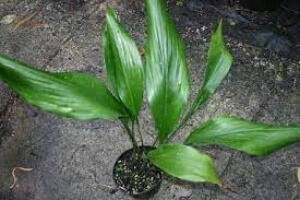
Source: johnjearrard.co.uk
Meaning 'starry sky' in Japanese, ‘Hoshi Zora’ has widely spaced faintly speckled spots on its large leaves. It almost looks like you've painted the wall just above this Cast Iron plant and forgot to move it to safety.
Aspidistra elatior ‘Asahi’
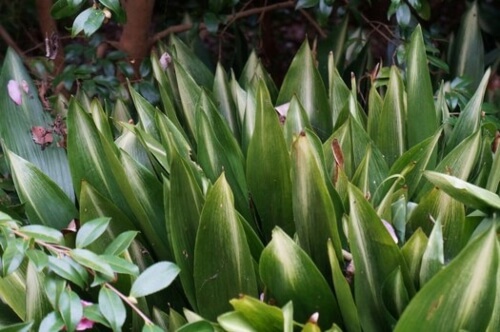
Source: plantlust.com
This Cast Iron plant has a gentle hue of white running through the centre of the leaf. Its name 'Asahi' means 'morning sun' in Japanese as the leaves open chocolate brown, turning green from the base upwards with a brush of light as if the morning sun is shining on them.
Aspidistra elatior ‘Milky Way’
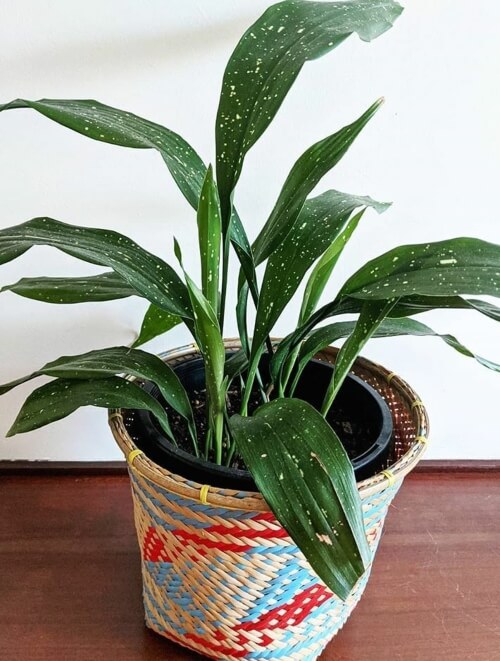
Source: chooseyourplant.com
‘Milky Way’ is similar to ‘Hoshi Zora’ but has many more speckles of white to creamy yellow flecks all over the plant's leaves, and more closely spaced together.
For a real impact, display both 'Milky Way' and 'Okame' Cast Iron plants together for a striking contrast of spots and stripes!
Aspidistra elatior ‘Lennon's Song’
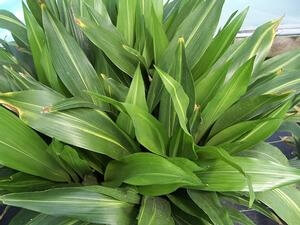
Source: quackingrassnursery.com
‘Lennon's Song’ has long narrow ends to its leaves and a central, paler green to mustardy yellow irregular stripe running through its centre.
Aspidistra elatior ‘Okame’

Source: plantdelights.com
With its stunningly painted leaves, this Aspidistra has streaks of white running through the leaves like ribbons of colour. 'Okame' literally translates as ‘tortoise’ but is also the name of the female half of the traditional Japanese theatre mask pair which has two names, Otafuku and Okame.
The tortoise is a lucky symbol for a long life which suits all Cast Iron Plants well.
Aspidistra elatior ‘Akebono’

Source: plantdelights.com
‘Akebono’ has irregular ready creamy yellow stripes similar to ‘Lennon's Song’ but displayed on wider leaves. Akebono means 'Day Break' or 'New Dawn' which is fitting for this Aspidistra as its creamy yellow stripes will mature to a bright white like the changing daylight hue.
Aspidistra elatior ‘Snow Cap’
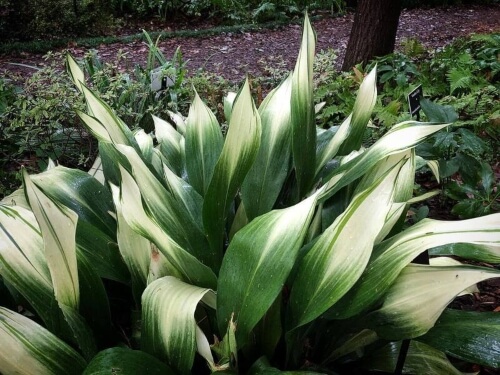
Source: davesgarden.com
One of the most stunning Aspidistra and one of my most coveted varieties is the ‘Snow Cap’. As the name suggests each leaf has a unique ombre of white on the tip fading to green about a third of the way down.
A perfect ode to snow-dusted mountain peaks. The leaves have a narrow border of green and will emerge with their white tips from the base.
Aspidistra ebianensis ‘Flowing Fountains’
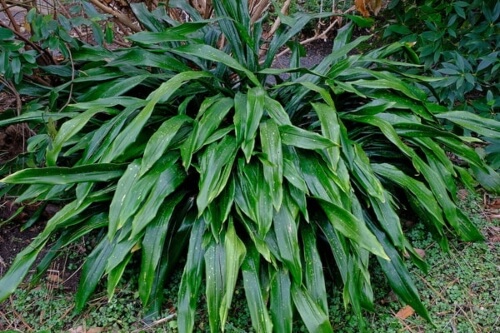
Source: plantdelights.com
The form of ‘Flowing Fountains’ is just like the name suggests, whereas A. elatior has upright and sword-like leaves, A. ebianensis takes a softer shape with cascading leaves arching downwards, an excellent ground cover Cast Iron Plant.
To add to Flowing Fountains interest its leaves are speckled with large creamy white spots.
Aspidistra elatior ‘Hoshi Zora’Meaning 'starry sky' in Japanese, ‘Hoshi Zora’ has widely spaced faintly speckled spots on its large leaves. It almost looks like you've painted the wall just above this Cast Iron plant and forgot to move it to safety. |  Source: johnjearrard.co.uk |
Aspidistra elatior ‘Asahi’This Cast Iron plant has a gentle hue of white running through the centre of the leaf. Its name 'Asahi' means 'morning sun' in Japanese as the leaves open chocolate brown, turning green from the base upwards with a brush of light as if the morning sun is shining on them. |  Source: plantlust.com |
Aspidistra elatior ‘Milky Way’‘Milky Way’ is similar to ‘Hoshi Zora’ but has many more speckles of white to creamy yellow flecks all over the plant's leaves, and more closely spaced together. For a real impact, display both 'Milky Way' and 'Okame' Cast Iron plants together for a striking contrast of spots and stripes! |  Source: chooseyourplant.com |
Aspidistra elatior ‘Lennon's Song’‘Lennon's Song’ has long narrow ends to its leaves and a central, paler green to mustardy yellow irregular stripe running through its centre. |  Source: quackingrassnursery.com |
Aspidistra elatior ‘Okame’With its stunningly painted leaves, this Aspidistra has streaks of white running through the leaves like ribbons of colour. 'Okame' literally translates as ‘tortoise’ but is also the name of the female half of the traditional Japanese theatre mask pair which has two names, Otafuku and Okame. The tortoise is a lucky symbol for a long life which suits all Cast Iron Plants well. |  Source: plantdelights.com |
Aspidistra elatior ‘Akebono’‘Akebono’ has irregular ready creamy yellow stripes similar to ‘Lennon's Song’ but displayed on wider leaves. Akebono means 'Day Break' or 'New Dawn' which is fitting for this Aspidistra as its creamy yellow stripes will mature to a bright white like the changing daylight hue. |  Source: plantdelights.com |
Aspidistra elatior ‘Snow Cap’One of the most stunning Aspidistra and one of my most coveted varieties is the ‘Snow Cap’. As the name suggests each leaf has a unique ombre of white on the tip fading to green about a third of the way down. A perfect ode to snow-dusted mountain peaks. The leaves have a narrow border of green and will emerge with their white tips from the base. |  Source: davesgarden.com |
Aspidistra ebianensis ‘Flowing Fountains’The form of ‘Flowing Fountains’ is just like the name suggests, whereas A. elatior has upright and sword-like leaves, A. ebianensis takes a softer shape with cascading leaves arching downwards, an excellent ground cover Cast Iron Plant. To add to Flowing Fountains interest its leaves are speckled with large creamy white spots. |  Source: plantdelights.com |
How to Grow Cast Iron Plant
Growing Cast Iron plant indoors couldn't be simpler, for the very same reason it became so popular with the very discerning Victorians, it's incredibly easy to look after so much so it's named after the strong and indestructible cast iron metal.
They are a great plant for the beginner gardener as they don't really require any special treatment, but following a few guidelines will help your Cast Iron plant thrive for many, many years to come.
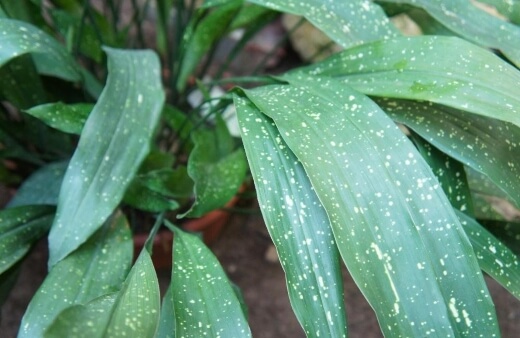
Growing Aspidistra elatior Indoors
Indoor Light Needs
Here is where your houseplant care may differ from your normal houseplant requirements, the Cast Iron dislikes direct light. Placing your Cast iron near a very bright window that gets direct sun will scorch its leaves. Save the shadier corners in your home for your Aspidistra, or hide it beneath many other wider leafed plants to mimic its natural shaded environment
What Soil to Use Indoors
Cast Iron plants aren't too fussy when it comes to soil requirements. When growing indoors, choose a good quality potting mix that has added drainage like grit or perlite. Your cast iron plant will dislike being repotted too frequently so choosing a good potting mix will be a good investment for the long term health of your plant.
Watering Cast Iron Plant Indoors
Aspidistra doesn't want much at all, but it will thoroughly dislike sitting in wet soil. The Cast Iron Plant can honestly tolerate even the most neglectful of watering routines so it's always best to err on the side of caution and make sure you're not over-loving your plant by drowning it.
Best Fertiliser to Use
The best fertiliser for your Aspidistra would be a well-balanced liquid fertiliser used a couple of times during the growing season. They are a slow-growing plant so overly fertilising won't make them grow any faster or bigger, but it may have adverse effects.
Growing Cast Iron Plant Outdoors
Outdoor Light Needs
Choose a sheltered spot if growing outdoors. Cast iron plants don't want to be the star of the show, they'll want to sit quietly in shady or wooded areas. If you choose to grow outside in warmer climates, making sure they're out of direct, strong, afternoon sunlight is key.
What Soil to Use Outdoors
Bar room plants will grow happily in almost any soil outdoors as long as they have good drainage. Steer clear from planting in any boggy areas of the garden or any areas that are heavy clay soil as these will retain too much water.
Watering Bar Room Plant Outdoors
Just like growing indoors, watching your outdoor-grown cast iron plant's water intake will help keep it happy and healthy. Protect your cast iron plant from any intensely heavy rain or make sure pot grown plants have good drainage by lifting pots onto feet if you see soil becoming waterlogged.
Temperature
Aspidistra won't survive frosts, so if your outdoor climate is a cold one, growing your Cast Iron plants in moveable pots would be the easiest way to enjoy them for as long as possible and keep them safe from harsh colder temperatures.
Propagating Cast Iron Plant
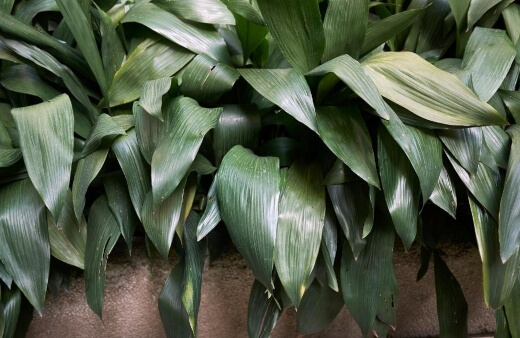
Propagating Aspidistra elatior from seed
The likelihood that your indoor grown Cast Iron plant will ever flower is extremely slim, further still to have that flower pollinated to produce seeds is just never going to happen. They're also very slow growers, so it would be the most inefficient way to produce new plants.
How to Propagate Cast Iron Plant from Division
This method is probably the most effective way of creating new plants and propagating your Cast Iron plant. Your plant will grow from rhizomatous roots below the surface of the soil and create new separate plants by themselves which should have their own separate root systems.
This is what you will divide from the parent plant and pot on. It's best not to do this too often as Aspidistra don't like to have their roots disturbed too often.
Cast Iron Plant Propagation from Cuttings
Taking cuttings from your Cast Iron plant is another way to propagate your plants and create new plants for free. All types of propagation is best done in the growing season as it will give your plant the best possible chance of growing strongly.
When you have teased out the separate parts and uncovered the roots, you can identify the best material to take a cutting from. Your cutting should include a good portion of the rhizome itself and hopefully have roots attached.
This cutting should then be grown indoors or in a protected area where you can monitor watering as your small root cutting can be prone to root rot before it is established.
Caring for Cast Iron Plant

The best way to care for your Cast Iron plant is to admire it from afar. It's more likely that you will kill your plant from loving it too much! A risk-free way of interacting with your plant is to dust those leaves.
All house plants are dust collectors so making sure their leaves are shiny and dust-free will definitely help keep your plant healthy.
Generally, bar room plants don't need much pruning, but if you notice any dead, damaged or diseased looking leaves it's always best to prune these off and monitor the plant for any future signs of disease.
Common Aspidistra elatior Pests and Diseases
Aspidistra elatior isn't called the 'Cast Iron Plant' for nothing, they're surprisingly hardy and resilient to most diseases, but can be prone to root rot. If you notice that the leaves of your Cast Iron plant are yellowing or browsing at the tips, this is a good sign that your plant is sitting in waterlogged soil and that it may develop root rot.
Luckily, this plant doesn't suffer too much from the regular pests that plague other house plants. Coming from a house that has seen action from every houseplant pest under the sun, our Cast Iron always seems to stay untouched.

However, if you do notice any unsavoury characters hanging around your plant then it's likely to be one of these classic culprits below:
Spider Mites
Very small grain-like insects that you may mistake for dust particles. If your Cast Iron Plant has any webbing on any part of the plants it's likely that you may have a spider mite infestation.
Mealy Bugs
Mealybugs are a little easier to spot being white and fluff looking. They will collect on the undersides of leaves and in the crevices of leaves and can easily spread from plant to plant and infest your Cast Iron Plant.
Thrips
There can be small elongated black or white insects that will suck on the sap of your Cast Iron plant and in turn damage its leaves.
Fungus Gnats
Fungus Gnats are a pollinator of the Cast Iron plant when grown outdoors, however, if you have a fungus gnat infestation in your home the larvae can cause damage to the roots.
You will be able to identify if you may have a fungus gnat larvae problem if you see the adult small black fly flying around your Cast Iron plant. The best possible way to test from any of the pests like the ones listed above is to check your plants regularly.
On first noticing any pest, the safest way to protect your plant from further infestation is to give your bar room plant a rinse with water to remove pests from the leaves.
The best way to do this would be to use a small pressure sprayer to gently but precisely spray the pests away from the plant and not down into the soil.
If your infestation continues there are other methods you can use such as Neem Oil and Castile Soap to wash the plants and then reduce the chance of any pests being able to survive.
Cast Iron Plants Frequently Asked Questions

Do cast iron plants need sun?
Cast iron plants do best in part shade but will survive in full sun with limited growth. For the best results with your hardy houseplant, try to grow it as far away from the window as possible in a warm, north-facing, room. This gives it loads of heat but limits the direct sun.
Why is it called a cast iron plant?
Cast iron plants get their name from their cast-iron constitution, and a reputation for being virtually indestructible houseplant, that is actively hard to kill.
Even if you ignored all of our advice about heat, watering and location, your cast iron plant would probably still forgive you.
Are cast iron plants toxic?
Cast iron plants are completely non-toxic to cats, dogs and humans. Like any plant not grown specifically for food, it’s not easily digestible and eating larger amounts will cause an upset stomach, but it won’t cause any lasting damage.
How long do cast iron plants live?
Cast iron plants are one of the longest-lived members of the Asparagaceae family, often reaching 50+ years in cultivation, and almost as long in the wild. Other than trees and shrubs there are very few plants that can outlive a cast iron plant.
Looking for more plants to grow indoor or outdoor? Check out our comprehensive guide to growing Rhapis palm in Australia.

Wrapping Up Our Cast Iron Plant Guide
It's truly one of the best house plants out there in my opinion, and you get a lot of impact for very little work! But if you find that you want to add a personal touch to your Aspidistra collection, there's no better inspiration than journeying back to its origins.
Aspidistra's elegant leaves were a favourite with ikebana artists who found their shapes to be perfect in creating the mindful forms needed in this traditional Japanese art of flower arranging.
If you want to get creative with your Cast Iron plants why not try Kokedama as the subject for these trendy hanging moss balls. For such a simple and unassuming plant, the cast iron plant can create an air of sophistication in your home that is hard to find in any other plant.
Published on March 22, 2022 by Maisie Blevins
Last Updated on February 26, 2025





Hello Gary, I read your guide on growing aspidistra. I have looked for good information on the internet and your guide is one of the better ones. I have some aspidistra and the only issue I can't find advice about is how deep to plant them. How deep should the rhizomes be? I found one source that says one inch below the soil.
Hi Chris,
Planting depth can oftentimes depend on the size of your plant and its root system.
Usually with a rhizomatous plant, a planting depth of one to two inches below the soil surface should be perfect for younger specimens, allowing the rhizomes to sit comfortably and settle into the new soil.
For larger plants, three to four inches may be better. Generally, having a few buds at or just below the soil surface should be a good indicator that the depth is more or less accurate.
For the actual soil depth, around 6 to 9 inches below the rhizomes should allow the roots to grow and establish themselves at a healthy pace.
I hope this helps you. Wishing you a successful planting experience with your aspidistra.
Gary Clarke